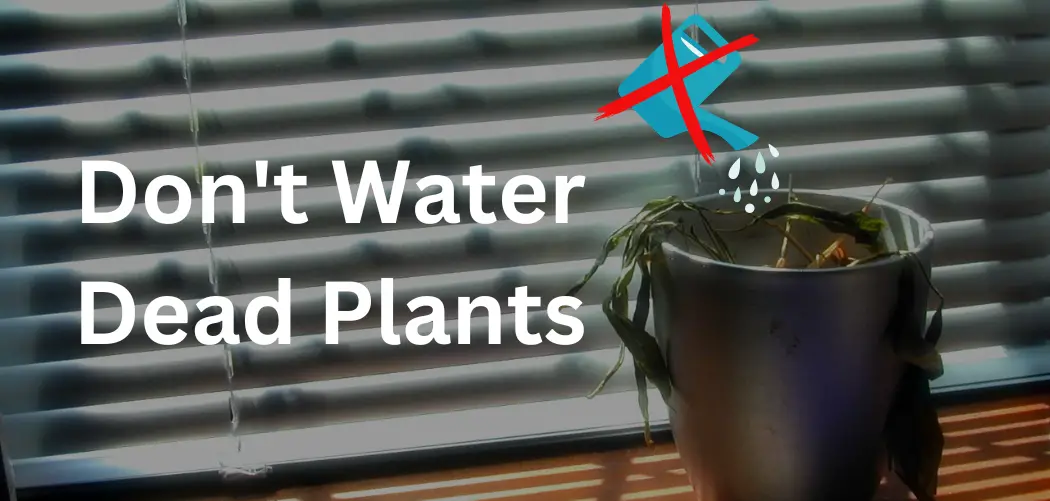We're an affiliate
We hope you love the products we recommend! Just so you know, we may collect a share of sales or other compensation from the links on this page. Thank you if you use our links, we really appreciate it!
As gardeners and plant enthusiasts, it is essential to recognize signs of distress in our beloved greenery. By doing so, we not only save resources and time but also help maintain a vibrant and healthy garden ecosystem. In this blog post, we will explore the various signs of a dead plant, the importance of not watering them, and how to effectively care for your green friends.
Table of Contents
Signs of a Dead Plant
- Lack of Growth or Wilting Leaves: One of the first indications that a plant might be dead is a significant decline or cessation of growth. If you notice wilting leaves that do not respond to watering, it could be a sign of a dying plant.
- Yellow or Brown Foliage: When a plant’s leaves turn yellow or brown and start falling off, it indicates stress and potential death. This discoloration is often due to a lack of nutrients or excessive watering.
- Brittle Stems and Branches: Healthy plants have supple and flexible stems, while dead plants exhibit brittleness and break easily. Gently touch the stems to assess their condition.
- Absence of New Shoots or Buds: In thriving plants, you’ll see new shoots and buds emerging as they continue to grow. Conversely, dead plants show no signs of new growth.
- Mold or Mildew Growth: The presence of mold or mildew on the plant’s leaves and stems indicates decay and potentially fatal conditions.
The Importance of Not Watering Dead Plants
- Preventing Resource Wastage: Water is a precious resource, and watering dead plants is a needless waste. By avoiding this practice, you conserve water and contribute to environmental preservation.
- Avoiding Soil Saturation and Root Rot: Overwatering dead plants can lead to waterlogged soil and suffocate the roots, causing root rot. Root rot is a fungal disease that is difficult to treat and can quickly spread to other healthy plants.
- Reducing the Risk of Fungal and Bacterial Diseases: Moist conditions in watered dead plants create an ideal environment for the growth and spread of harmful fungi and bacteria. These can infect nearby plants and pose a serious threat to your entire garden.
- Conserving Water Resources: By using water wisely and only on plants that truly need it, you contribute to a sustainable water ecosystem and help combat water scarcity issues.
How to Confirm if a Plant is Dead
- Conducting the Scratch Test: Gently scratch the bark or stem of the plant with your fingernail. If the tissue underneath is dry, brittle, and brown, it is likely a dead plant.
- Checking for Flexibility in Stems and Branches: Healthy plant stems are flexible and bend without breaking. Dead plant stems will snap easily due to their brittleness.
- Assessing the Root System: Carefully dig around the plant’s base to examine the root system. If the roots are brown, mushy, or have a foul odor, the plant is dead.
- Using the “Snap and Bend” Method: For smaller plants, carefully bend the main stem. A live plant will have a green, pliable stem that bends, while a dead plant’s stem will snap cleanly.
Factors Contributing to Plant Death
- Incorrect Watering Practices: Overwatering or underwatering plants can lead to stress and eventual death. Understanding the water needs of different plant species is crucial for their survival.
- Extreme Weather Conditions: Harsh weather, such as prolonged droughts or severe frosts, can cause significant stress to plants, leading to their demise.
- Pest and Disease Infestations: Ignoring pest and disease issues can quickly lead to the death of the affected plant and the spread of problems to others.
- Soil Nutrient Deficiencies: A lack of essential nutrients in the soil can weaken plants and make them more susceptible to diseases and environmental stressors.
Best Practices for Proper Plant Care
- Researching Plant-Specific Care Guidelines: Each plant species has unique care requirements. Study and understand the needs of your plants to ensure their health and longevity.
- Observing Watering Needs and Avoiding Overwatering: Regularly monitor the moisture level of the soil and water plants only when necessary. Create a watering schedule based on individual plant needs.
- Providing Proper Sunlight and Shade: Position plants in areas that receive the appropriate amount of sunlight based on their requirements.
- Regularly Inspecting and Monitoring Plants: Frequently inspect your plants for any signs of distress, pests, or diseases. Early detection can save ailing plants from a fatal outcome.
Reviving Stressed Plants vs. Removing Dead Ones
- Steps to Revive Stressed, Potentially Salvageable Plants: If you catch a plant in a state of stress but not yet dead, you can take measures such as pruning, improving soil conditions, and adjusting watering to promote recovery.
- Proper Disposal Methods for Confirmed Dead Plants: For plants that are beyond saving, promptly remove and dispose of them properly. This helps prevent the spread of diseases and pests to healthy plants.
Preventative Measures to Avoid Plant Fatality
- Implementing a Watering Schedule and Using the Right Watering Techniques: Avoid overwatering or underwatering by adhering to a consistent watering schedule and employing appropriate watering methods like drip irrigation.
- Choosing Suitable Plants for Your Climate and Environment: Select plants that are well-suited to your local climate and environmental conditions. Native and adaptive plants tend to fare better in their natural surroundings.
- Using High-Quality Soil and Fertilizers: Ensure your garden soil is rich in nutrients and free from contaminants that could harm plants. Use organic fertilizers to support healthy growth.
- Regularly Inspecting and Maintaining Plants: Frequent inspections allow you to address issues promptly, prevent problems from escalating, and keep your garden in top shape.
Benefits of Removing Dead Plants
- Creating Space for Healthy Plant Growth: Removing dead plants opens up space for new plantings or allows neighboring healthy plants to thrive without competition.
- Preventing the Spread of Diseases and Pests: Eliminating dead plants stops diseases and pests from spreading to nearby greenery, preserving the overall health of your garden.
- Enhancing the Overall Aesthetics of Your Garden: A well-maintained garden with vibrant, healthy plants enhances the visual appeal of your outdoor space.
Conclusion
Identifying dead plants and avoiding watering them is fundamental to maintaining a successful and thriving garden. By recognizing the signs of ailing plants and taking appropriate actions, you promote a healthier and more sustainable garden ecosystem. Remember to research individual plant care guidelines, monitor their needs, and promptly address any issues that arise. With proper care and attention, you can create a flourishing garden that brings joy and beauty to your life while conserving valuable resources and benefiting the environment. Happy gardening!


